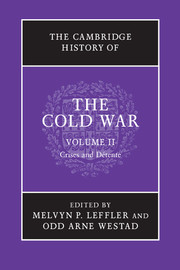Book contents
- Frontmatter
- 1 Grand strategies in the Cold War
- 2 Identity and the Cold War
- 3 Economic aspects of the Cold War, 1962–1975
- 4 The Cuban missile crisis
- 5 Nuclear competition in an era of stalemate, 1963–1975
- 6 US foreign policy from Kennedy to Johnson
- 7 Soviet foreign policy, 1962–1975
- 8 France, “Gaullism,” and the Cold War
- 9 European integration and the Cold War
- 10 Détente in Europe, 1962–1975
- 11 Eastern Europe: Stalinism to Solidarity
- 12 The Cold War and the transformation of the Mediterranean, 1960–1975
- 13 The Cold War in the Third World, 1963–1975
- 14 The Indochina wars and the Cold War, 1945–1975
- 15 The Cold War in the Middle East: Suez crisis to Camp David Accords
- 16 Cuba and the Cold War, 1959–1980
- 17 The Sino-Soviet split
- 18 Détente in the Nixon–Ford years, 1969–1976
- 19 Nuclear proliferation and non-proliferation during the Cold War
- 20 Intelligence in the Cold War
- 21 Reading, viewing, and tuning in to the Cold War
- 22 Counter-cultures: the rebellions against the Cold War order, 1965–1975
- 23 The structure of great power politics, 1963–1975
- 24 The Cold War and the social and economic history of the twentieth century
- Bibliographical essay
- Index
- References
18 - Détente in the Nixon–Ford years, 1969–1976
Published online by Cambridge University Press: 28 September 2010
- Frontmatter
- 1 Grand strategies in the Cold War
- 2 Identity and the Cold War
- 3 Economic aspects of the Cold War, 1962–1975
- 4 The Cuban missile crisis
- 5 Nuclear competition in an era of stalemate, 1963–1975
- 6 US foreign policy from Kennedy to Johnson
- 7 Soviet foreign policy, 1962–1975
- 8 France, “Gaullism,” and the Cold War
- 9 European integration and the Cold War
- 10 Détente in Europe, 1962–1975
- 11 Eastern Europe: Stalinism to Solidarity
- 12 The Cold War and the transformation of the Mediterranean, 1960–1975
- 13 The Cold War in the Third World, 1963–1975
- 14 The Indochina wars and the Cold War, 1945–1975
- 15 The Cold War in the Middle East: Suez crisis to Camp David Accords
- 16 Cuba and the Cold War, 1959–1980
- 17 The Sino-Soviet split
- 18 Détente in the Nixon–Ford years, 1969–1976
- 19 Nuclear proliferation and non-proliferation during the Cold War
- 20 Intelligence in the Cold War
- 21 Reading, viewing, and tuning in to the Cold War
- 22 Counter-cultures: the rebellions against the Cold War order, 1965–1975
- 23 The structure of great power politics, 1963–1975
- 24 The Cold War and the social and economic history of the twentieth century
- Bibliographical essay
- Index
- References
Summary
President Richard M. Nixon declared in his inaugural address on January 20, 1969, that “after a period of confrontation, we are entering an era of negotiations” with the Soviet Union. Privately, he told the Soviet foreign minister, Andrei Gromyko, that in the United States “whenever elections approached, political leaders were tempted to take a belligerent anti-Communist line,” but that Nixon himself “did not consider such an approach to be in the interests of world peace or of Soviet–American relations.”
These conciliatory words toward America’s Cold War rival seemed surprising at the time, since Nixon had played important parts in Congress from1947 to 1952 and as vice president from 1953 to 1961 in shaping confrontational American policies toward the Soviet Union and Communism. As president, Nixon put aside his earlier criticism of the Communist system, choosing to focus instead on expanding areas of common interest between the Cold War rivals in order to promote what he characterized as a “structure of peace.” He developed personal relationships with Soviet leaders, and the United States and the Soviet Union reached a series of agreements on arms control, commercial relations, and political cooperation that fostered a fragile détente between them.
- Type
- Chapter
- Information
- The Cambridge History of the Cold War , pp. 373 - 394Publisher: Cambridge University PressPrint publication year: 2010
References
- 6
- Cited by

